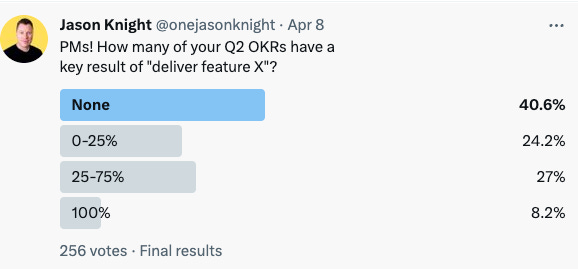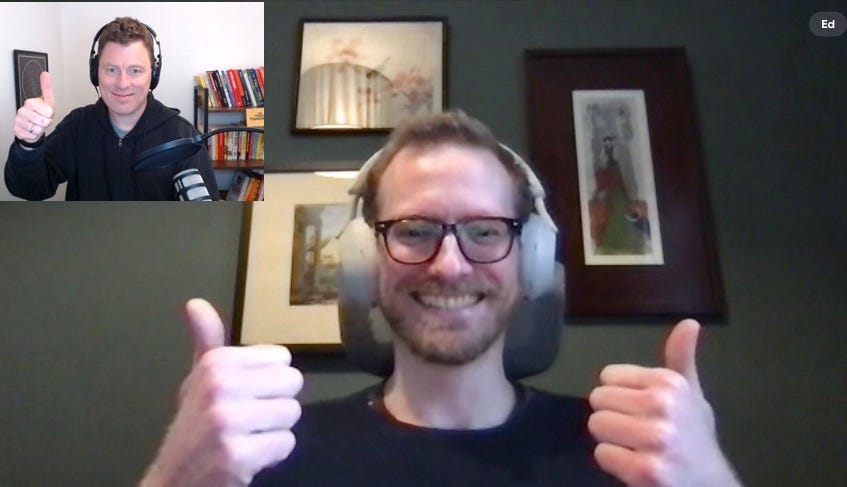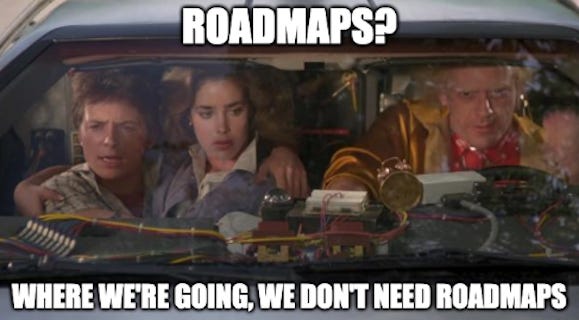Some heartening news from the front lines of product management. 60% of product managers don't have entirely “deliver this feature” OKRs! We’re going to make it, folks!
In all seriousness and, as per my previous chats with such greats as Christina Wodtke and Jeff Gothelf, OKRs are all about defining a desired change you want to see in customer behaviour (the outcome), and how you measure that it happened (the key results). They’re there to inspire empowered teams to find a path to that goal, whatever the path may be. They’re generally not there to measure progress towards one specific path.
That’s not to say that sometimes you don’t have to define a specific path. There are various situations that might be appropriate, but don’t cram them into the OKR framework. What’s the point?
A message from our sponsor
This issue is sponsored by My Mentor Path, a free peer mentoring platform that I’ve helped to set up to ensure that product people are able to get the support they need to help further their careers, as well as pay it forward to the next generation. You can sign up now as a mentor, a mentee or both. We’ve recently launched new mentor discoverability features, as well as allowing you to have more mentors at once, all to enable you to develop your careers the way you want. Check it out now!
New Podcast Episode: (Don't) Scream If You Want To Go Faster - How to Accelerate Product Development
The first time I came across Ed Biden, it became quite clear that we’d both applied for the same VP of Product job at FutureLearn, a UK-based education platform. I didn’t even get a callback, but Ed did, and he went on to thrive and become their Chief Product Officer before moving on to his own stuff. He’s currently trying to re-invent product management learning with his new startup, Hustle Badger, and he’s also passionate about speeding up product development.
We spoke about all this and more, so check the episode out on your favourite podcast app, or right here. Make sure you share it with your friends!
Radical transparency can help get away from "Go faster" execs
CEOs and business leaders often complain about speed and wish everything could be faster. It's important to be transparent with them, let them know the trade-offs & give them a stake in the decision so they buy in.
“What is the suggested frequency to share roadmaps with stakeholders, and what is the best format?”
Ah, roadmaps. It seems like there’s a new article every week about whether they should have dates on, whether they’re delivery plans, whether they’re commitments or not. This is not one of those articles. I’m not going to argue about any of that stuff. Let’s assume that your roadmap is whatever you need it to be
There are some things that I, personally speaking, prefer to do with roadmaps.
Keep roadmaps as high-level as possible. Stick to themes and initiatives.
Do not commit to specific dates that are more granular than a quarter.
Ensure that people realise that they may change and do not contain commitments.
Use them as storytelling devices rather than a delivery plan.
I’m sure that these will resonate with many product people but also collide horribly with the demands and desires of commercially-minded stakeholders. That’s OK - you don’t win points for perfect roadmaps.
But, back to the question. Presuming that you have a roadmap format agreed upon, what do you do with it?
Roadmaps are, at their heart, a communications tool
Whatever format you choose, however hard its commitments, your roadmap is fundamentally a communications tool. A way to describe, in a way your stakeholders can consume, what it is you’re planning to be up to. Therefore, your roadmap needs to be consumable. It needs to be public. It needs to be somewhere people can find it. If people can’t find your roadmap, it might as well not exist.
Share, share and share again
Putting a document in a place is essential, but not enough. You need to be talking about this roadmap very frequently. If you’re doing “show and tell” type sessions or other all-hands product updates, you should be presenting the roadmap during that session. Do you have monthly sessions with sales, marketing or customer success? Show it at those sessions too. Have a standing slot at the leadership meeting? Show it again. If you don’t keep people up-to-date then they’ll start filling in gaps with their own assumptions and faulty memories.
Roadmaps should be slow-moving, so some people might tune out…
If your roadmap changes every 2 weeks you might have deeper problems that can be solved than with a Powerpoint slide. Roadmaps that are set at the right level should be relatively slow-moving. There’s plenty of work going on, but roadmaps aren’t Kanban boards or timesheets. However, the problem with slow-moving roadmaps is that they start to look the same.
… so, concentrate on changes, not presenting the entire document again and again
Present the delta between last time and this time. Don’t just sit there saying “We’re still working on X! We’re still working on Y!” It’s more interesting to know that “we’ve deprioritised Z because W”. It gives you a chance to explain why that has happened, and what supporting evidence there is. People shouldn’t have to search for differences. We’re not making children’s activity guides here.
Experiment with different formats to make things stick
Maybe you’re using some cool SaaS tool to represent your roadmap, or maybe you've got a Powerpoint slide, or you’ve built some 3D rotating cube that people can zoom in and out of. Whatever you’ve built, it’s going to start looking stale pretty soon.
And that’s OK! But, consider maybe not just showing the same slide every few weeks, with the same colours and the same templates and the same company logo. Maybe record a video, an audio message, a fake press release, or literally any way you can think of that makes it not look exactly like before.
People tune stuff out - you can’t stop that happening - so try to find as many ways to interrupt that as possible. You don’t have to be the most creative person on the planet, and some stuff won’t work, but try anything you can to provide record-scratch moments that will help people remember the messages you want them to remember.
In this newsletter, I’ve tried something a little different. Rather than just writing about whatever random product management stuff is on my mind, I’m taking some of the questions I get from my fireside chat sessions and answering those. Hopefully, these will be interesting to lots of people. Feel free to vote or submit your own questions!
Writing this newsletter is fun, and I love to give stuff away for free. But, if you want to buy me a coffee, you can always buy me a coffee. In any case, if you enjoyed this issue, please share it with your friends!






Can the next poll be "how many of your product teams actually hit your OKR?"